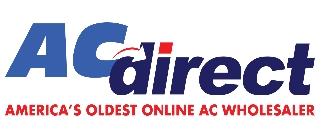Don’t Let April Showers Flood Your HVAC - Protect Your System Now
-
 By
Michael Haines
By
Michael Haines
- Apr 24, 2025

If you live in the Northeast, you know April is unpredictable. One minute it's sunny and spring-like, the next it’s pouring rain for days. While we all welcome warmer temperatures, those heavy spring rains can put your HVAC system at serious risk, especially if your furnace or air conditioning unit is located in a basement or crawl space prone to flooding.
At AC Direct, we’ve helped countless homeowners replace flooded gas furnaces or central air conditioners that could have been protected with simple steps. Let’s walk through the specific ways April rainfall can damage your system, what you can do to prevent it, and which accessories and upgrades offer the best protection for your home, at wholesale prices.
Why April Rainfall Threatens HVAC Systems in the Northeast
When Rain Turns Into Risk
The Northeast averages 4 to 6 inches of rain in April, with some areas seeing more due to coastal storms and saturated ground. Homes in low-lying neighborhoods or those with poor yard drainage often experience water pooling near or inside their basements. If your HVAC unit sits in one of these locations, even minor flooding can damage equipment.
Rainwater enters basements through foundation cracks, overwhelmed sump pumps, or aging storm drainage systems. In homes across Rhode Island, Connecticut, and New Jersey, HVAC systems are frequently placed on the floor of utility rooms or unfinished basements, making them vulnerable to even two inches of water.
Financial Costs Can Be Steep
Flooded HVAC systems are expensive to repair. A damaged air handler or circuit board might cost $800 to replace. If the evaporator coil corrodes due to moisture, a full system replacement could cost $3,000 to $7,000. Add in mold remediation or ductwork restoration, and the price goes even higher.
Water-damaged components also tend to fail slowly. Even if your system seems to run after a flood, hidden corrosion can cause problems a few weeks later, usually just when you start relying on it again.
Health and Comfort Also Take a Hit
A flooded furnace or AC unit might shut down completely, leaving your home unheated on cold April nights or without cooling during a spring heat wave. Electrical shorts from moisture exposure can create safety hazards. Mold growth in ductwork triggered by high humidity or standing water will further degrade your indoor air quality, especially for allergy sufferers.
How Flooding and Moisture Affect HVAC Equipment
Where the Water Comes From
Most flooding comes from a combination of spring downpours and saturated soil. Water collects around your basement walls if your home has poor exterior drainage or the land slopes toward the foundation. Cracks or unsealed windows allow it inside. From there, water spreads into utility areas, storage zones, and furnace closets.
Homes near rivers, marshes, or the coast often have the added challenge of high water tables or storm surges during spring storms. If you’ve had basement water issues before, your HVAC equipment is at risk unless it's elevated or protected.
Moisture Can Be Just as Damaging as Floodwater
Spring’s 60 to 70 percent humidity creates problems even without standing water. Moisture causes rust on coils and burner assemblies, promotes mold in ductwork, and weakens adhesives in insulation. The Humidity inside the home reduces energy efficiency and can strain system components.
Old systems are particularly vulnerable. Units installed 15 or more years ago are less likely to have sealed electronics, insulated panels, or elevated platforms that are standard in today’s flood-aware HVAC designs.
Pre-Season HVAC Maintenance Can Prevent Water Damage
Start with a Spring Tune-Up
HVAC maintenance is the first line of defense against flooding problems. A spring service call ensures your heat pump, furnace, or central air system is working efficiently and is protected against moisture-related issues.
During this check-up, a certified technician should:
-
Clear the condensate drain lines to prevent internal flooding
-
Inspect and reseal electrical components.
-
Check for rust or corrosion on coils and panels.
-
Confirm the system is elevated if installed in a basement.
-
Test dehumidification functionality
AC Direct partners with certified contractors in your area who specialize in servicing homes vulnerable to flooding. These pros understand the risks and will check everything from drainage slope to insulation around duct boots.
What You Can Do at Home
In addition to a professional service, check your HVAC area yourself. Ensure the floor around your furnace and AC unit is dry and level. Clear any stored boxes or clutter that might block airflow or trap moisture. Test your sump pump (if applicable) and consider adding a battery backup.
Also check the exterior drainage near your outdoor condenser. Clear any buildup of mulch or soil around the base. The unit should sit at least two inches above grade and be level to prevent puddling underneath.
Flood Prevention Accessories for HVAC Protection
Dehumidifiers Offer Crucial Moisture Control
Installing a whole-home dehumidifier is one of the most effective ways to defend against spring moisture. These systems connect to your HVAC ductwork and work alongside your air conditioner or gas furnace and AC combo to keep relative humidity between 40 and 50 percent.
By controlling basement humidity, you reduce the chance of mold, preserve duct integrity, and reduce the load on your HVAC system.
Water Sensors Offer Smart Detection
Leak detection sensors can alert you the moment water is detected near your HVAC system. These compact devices integrate with smart thermostats and alert your phone if a leak or flood is detected.
While we no longer reference brands like Ecobee, Honeywell offers smart systems that integrate with IAQ accessories. These sensors are small investments that can prevent thousands in losses.
Filters and IAQ Add-Ons Help Protect Your System
Install high-efficiency air filters with a MERV 13 rating or higher to reduce allergens that thrive in moist environments. Clean filters prevent airflow blockages that cause condensate overflow, and better filtration helps keep ducts mold-free.
Also consider installing IAQ accessories like air or coil purifiers if you live in a high-humidity zone.
Raise or Relocate Units If Needed
If your HVAC unit sits directly on the basement floor, ask your contractor if it can be elevated on a platform or moved to a higher location. Even raising it four to six inches off the ground can protect against light flooding or drainage issues.
AC Direct offers resources to help homeowners plan HVAC layouts and connect with licensed installers in flood-prone neighborhoods.
Why Take Action in April?
Spring Storms Are Fast and Unforgiving
Once April’s storm season starts, it’s tough to find quick service or equipment. Demand spikes, and backorders are common. Acting now gives you time to prepare before heavy rainfall catches you off guard.
With HVAC systems and IAQ accessories available for direct purchase online at wholesale prices, AC Direct helps you beat the rush.
Avoid Emergency Costs
Emergency HVAC repairs following flood damage cost far more than preventive maintenance. A blocked condensate line may only take $150 to fix—if left unattended, it can result in a $2,000 repair and weeks without AC.
Depending on features, many dehumidifiers or sensors cost between $50 and $500. These small investments pay for themselves after one near-miss.
Rebates and Financing Make It Easy
The Inflation Reduction Act offers up to $2,000 in tax credits for installing high-efficiency heat pumps and $600 for qualified gas furnaces for sale. Some of these systems include integrated moisture control or pair with smart accessories.
Mass Save and other Northeast programs offer rebates for maintenance, smart thermostats, and even dehumidifiers. Installing water sensors may also qualify you for premium reductions on flood insurance.
AC Direct’s team is happy to help you find and apply these rebates to lower your total cost.
Real Homeowner Stories from the Northeast
Flood Averted in New Haven
The Costa family in Connecticut used AC Direct to purchase a whole-home dehumidifier and smart thermostat compatible with water sensors. When a major April storm hit, their alert system caught a leak before it reached their furnace. Their home stayed dry, and they received a $100 rebate through their utility.
Peace of Mind in Providence
The Walsh family’s basement in Rhode Island had flooded before. They upgraded with a new 3.5 ton AC unit with gas furnace mounted on a raised concrete platform and added a dehumidifier. Their spring maintenance also uncovered a clogged drain line, preventing what would’ve been a major AC failure. Their utility bills went down 10 percent after the upgrade.
Shop Smart and Stay Dry with AC Direct
Browse our wholesale-priced HVAC accessories, filters, and moisture-control solutions today. Whether you’re protecting your furnace, heat pump, or AC unit, we’ve got what you need to stay ahead of April storms.
Our team is available to help you choose the right IAQ add-ons, verify compatibility, and connect you with certified installers in your area. Financing options and rebates make it even easier to protect your home and your investment this spring.

 and now, NASCAR Racing Sponsor
and now, NASCAR Racing Sponsor










